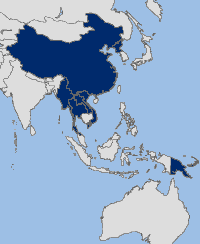Regional Development Mission for Asia
Background

The Regional Development Mission for Asia (RDMA) is a vital part of USAID’s efforts to support U.S. foreign policy priorities in Asia and to address global climate change and associated development challenges. RDMA implements both regional programs that address transnational development challenges, as well as bilateral programs in several Asian countries without existing USAID presence, such as China and Thailand. RDMA technical programs cover 11 countries in Southeast Asia, South Asia, East Asia, and the Pacific.
The Climate Context
During the next 25 years, the direction that Asian countries embark upon to meet their energy needs will have profound impacts on global climate change and energy security for the region and the world. Asia currently accounts for about 26% of global carbon dioxide (CO2) emissions, and its share of emissions is projected to increase to nearly 50% by 2030. China is now the world’s largest emitter of CO2 – years earlier than anticipated. In addition, the burning of coal to meet Asia’s energy needs is projected to increase five fold by 2030, accelerating greenhouse gas (GHG) emissions and further contributing to global climate change.
Increasingly, Asian countries are importing fossil fuels to sustain their rapid economic growth, and this is raising concerns about world energy security. By 2030, it is expected that 80 percent of Asia’s oil will be imported from the Middle East. The impact of urban air pollution on health and mortality in Asia is severe. Eighteen of the world’s 20 most polluted cities are in Asia, 16 of which are in China alone. Urban air pollution in Asia is linked to 500,000 premature deaths every year, accounting for 65% of premature deaths from air pollution worldwide.
Asia is also among the world’s regions most vulnerable to climate impacts. Several Pacific Islands and the Mekong and Ganges River Deltas are already showing signs of salt-water intrusion, and numerous coastal areas – including important agricultural areas and large cities like Shanghai and Bangkok – are directly threatened by long-term sea-level rise. Other climate risks include increased incidence of floods, drought, severe storms, and water shortages. It is predicted that all glaciers in the Tibetan Plateau may disappear by 2035, affecting water supply for about half a billion people as well as extensive hydropower infrastructure.
Eco-Asia Clean Development and Climate Program (CDCP)
ECO-Asia CDCP seeks to promote market transformation for increased investment in clean energy technologies and practices that mitigate greenhouse gas emissions while promoting improved economic productivity, air quality, and energy security. ECO-Asia CDCP works in China, Indonesia, Philippines, Thailand, and Vietnam, as well as in India in part through U.S. Department of State funding under the Asia Pacific Partnership for Clean Development and Climate (APP). ECO-Asia CDCP is working in four primary areas:
- Improving the efficiency of coal power generation through cleaner coal technology and practices (supply side efficiency) in partnership with the Association of South East Asian Nations (ASEAN) Forum on Coal (AFOC), and the World Bank.
- Increasing the use of high quality energy efficient lighting (demand side efficiency) by harmonizing product quality and testing standards in cooperation with OSRAM, Philips Lighting, and several domestic manufacturers, national lighting associations and testing centers, and the Government of Australia.
- Facilitating increased financing for clean energy by promoting international best practices in energy efficiency procurements in China and, under APP, development of State-level Clean Energy Funds in India.
- Regional knowledge sharing to build capacity and replicate best practices, including organizing the annual Asia Clean Energy Forum and preparing a major regional analysis, From Ideas to Action: Clean Energy Solutions for Asia to Address Climate Change, which prioritizes a full range of climate change mitigation options for the region.
New Climate Change Activities
Starting in 2008, USAID/RDMA will be exploring opportunities for expanding its work in clean energy, and introducing new activities that promote carbon sequestration and climate change adaptation in the region.
Partners
USAID’s partners in climate change activities in Asia include:
- Asian Development Bank (ADB)
- Asia-Pacific Economic Cooperation (APEC)
- Asia-Pacific Partnership for Clean Development and Climate (APP)
- Association of South East Asian Nations (ASEAN)
- International Resources Group (IRG)
- World Bank/Global Environment Facility
Because partners change as new activities arise, this list of partners is not comprehensive.
Back to Top ^
|


